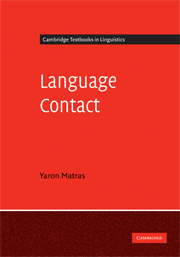Book contents
- Frontmatter
- Contents
- List of figures
- Preface
- List of abbreviations
- 1 Introduction
- 2 An emerging multilingual repertoire
- 3 Societal multilingualism
- 4 Acquiring and maintaining a bilingual repertoire
- 5 Crossing the boundaries: codeswitching in conversation
- 6 The replication of linguistic ‘matter’
- 7 Lexical borrowing
- 8 Grammatical and phonological borrowing
- 9 Converging structures: pattern replication
- 10 Contact languages
- 11 Outlook
- Notes
- References
- Author index
- Language index
- Subject index
8 - Grammatical and phonological borrowing
Published online by Cambridge University Press: 05 June 2012
- Frontmatter
- Contents
- List of figures
- Preface
- List of abbreviations
- 1 Introduction
- 2 An emerging multilingual repertoire
- 3 Societal multilingualism
- 4 Acquiring and maintaining a bilingual repertoire
- 5 Crossing the boundaries: codeswitching in conversation
- 6 The replication of linguistic ‘matter’
- 7 Lexical borrowing
- 8 Grammatical and phonological borrowing
- 9 Converging structures: pattern replication
- 10 Contact languages
- 11 Outlook
- Notes
- References
- Author index
- Language index
- Subject index
Summary
Grammatical function words
Discourse markers and connectors
Studies published over the past two decades or so, beginning with the works by Brody (1987) and Salmons (1990), have established a widespread consensus that discourse markers occupy a position at the very top of the borrowability hierarchy. This holds true at least for the type of contact situations characterised by unidirectional bilingualism and diglossia, where the recipient language tends to be reserved for more personal, informal domains of interaction, and is often an oral and/or minority language. The unidirectionality of bilingualism and the fact that the bilingual mode will tend to dominate interaction in the recipient language both play an important role in situations where speakers license themselves to employ word-forms from the ‘outside’ language on a regular basis when interacting in the ‘inside’ language (cf. Matras 1998a, 2000c, 2007a).
Within the broader class of discourse markers and connectors, further borrowability hierarchies appear within functional and structural sub-classes. In Matras (1998a) I proposed the principle of ‘pragmatic detachability’. This principle captures the tendency of a certain type of discourse marker to be detachable from the main sentential frame not just in a structural sense, as a result of their clause-peripheral position, but also from the bulk of the lexicon that speakers are more easily able to identify as appropriate in a particular context of interaction (see also Fuller 2001).
- Type
- Chapter
- Information
- Language Contact , pp. 193 - 233Publisher: Cambridge University PressPrint publication year: 2009

